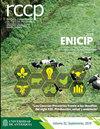Fermentative characteristics and nutritional value of sugarcane silage added with two types of urea
IF 0.5
4区 农林科学
Q4 AGRICULTURE, DAIRY & ANIMAL SCIENCE
引用次数: 2
Abstract
Background: Dry matter (DM) loss is high in sugarcane silage due to its high content of soluble carbohydrates which favors yeast growth and ethanol production, thus reducing the nutritional value of the preserved forage. Objective: To determine the effect of adding two types of urea at two concentration levels to sugarcane silage on the nutritional value and fermentative characteristics of the silage. Methods: A completely randomized 2×2+1 factorial design was used, based on two types of urea (conventional and protected), two urea concentration (0.5 and 1.0% of the natural matter), and a control (sugarcane silage with no additives). Six replicates were used. The mixture was placed in PVC silos and opened after 60 days. Results: There was no difference in DM content or effluent losses by the addition of urea. In regards to neutral detergent fiber, acid detergent fiber, and lignin, decreased levels were observed compared to the control, regardless of urea type. Urea type and concentration had an effect on ammoniacal nitrogen content, with higher values for conventional urea, but not affecting the pH. The addition of urea to sugarcane silage reduced gas losses and raised the levels of crude protein, ether extract, and effective degradability. Conclusion: Adding protected or conventional urea at 1% of natural matter at the time of sugarcane ensiling reduces gas losses and improves nutritional composition of the silage.添加两种尿素的甘蔗青贮饲料发酵特性及营养价值
背景:甘蔗青贮饲料中干物质(DM)损失高,因为其可溶性碳水化合物含量高,有利于酵母生长和乙醇生产,从而降低了保存饲料的营养价值。目的:探讨在甘蔗青贮饲料中添加两种不同浓度的尿素对青贮饲料营养价值和发酵特性的影响。方法:采用完全随机的2×2+1因子设计,基于两种类型的尿素(常规和保护)、两种尿素浓度(天然物质的0.5%和1.0%)和对照(不含添加剂的甘蔗青贮)。使用了六个重复。将混合物放置在PVC筒仓中,并在60天后打开。结果:尿素的加入对DM含量和出水损失没有影响。关于中性洗涤剂纤维、酸性洗涤剂纤维和木质素,与对照相比,无论尿素类型如何,都观察到水平下降。尿素的类型和浓度对氨态氮含量有影响,传统尿素的值更高,但不影响pH值。在甘蔗青贮饲料中添加尿素减少了气体损失,提高了粗蛋白、醚提取物和有效降解性的水平。结论:在甘蔗青贮时添加1%天然物质的保护尿素或常规尿素,可减少气体损失,改善青贮饲料的营养成分。
本文章由计算机程序翻译,如有差异,请以英文原文为准。
求助全文
约1分钟内获得全文
求助全文
来源期刊

Revista Colombiana De Ciencias Pecuarias
AGRICULTURE, DAIRY & ANIMAL SCIENCE-
CiteScore
0.80
自引率
0.00%
发文量
18
审稿时长
6-12 weeks
期刊介绍:
The editors of Revista Colombiana de Ciencias Pecuarias (RCCP) welcome the submission of original manuscripts on experimental and clinical studies associated with the broad areas of animal sciences and veterinary medicine as they interface with biochemistry, molecular biology, physiology, pharmacology, toxicology, pathology, microbiology, parasitology, immunology and epidemiology. The scope of the journal includes studies of basic and applied research in animal management and production, feeding and nutrition, reproduction, breeding, genetics, animal welfare and behavior; as well as animal production focussed from biotechnology, soil science, agrostology, silvopastoral systems, livestock economics and the environment.
The criteria for acceptance of papers submitted for publication are originality, quality and clarity of the content. Each contribution must be based on original, unpublished research that has not been simultaneously submitted to other journals. All papers will be peer reviewed. All authors bear responsibility for ensuring the integrity and quality of their reported research. It is the author''s responsibility to secure permission to use figures or tables that have been published elsewhere.
Contributions may be classified as original research, review, rapid communication, clinical case studies or methodological articles, as well as news/commentaries or letters to the editor. Most review articles are invited by the editor. Authors interested in submitting a review article should contact the corresponding editor. Rapid publication of original manuscripts is a goal of the journal. Manuscripts must be written in English. Each manuscript is considered for publication with the understanding that it has not been simultaneously submitted to any other journal. Upon acceptance for publication, papers are subject to editorial review and revision.
 求助内容:
求助内容: 应助结果提醒方式:
应助结果提醒方式:


